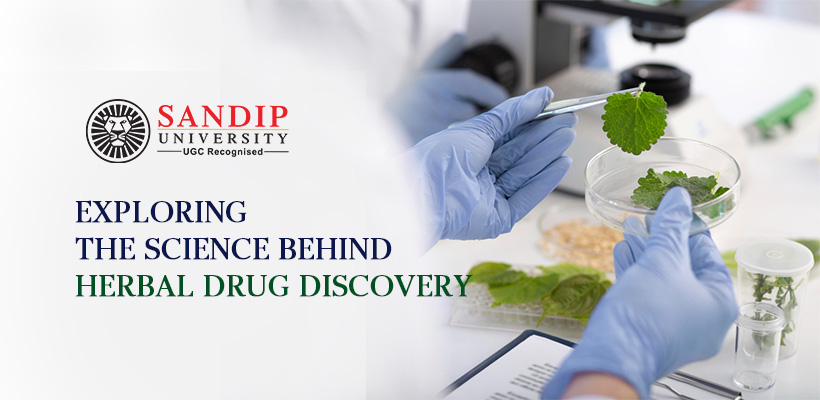Medicinal plants are nature’s blessings to human beings to make a disease-free healthy life. The Indian landscape is brimming with a variety of rare and relatively unexplored medicinal plants having tremendous pharmacological applications. The Indian medicinal plants range is well renowned for its traditional treatment, including Ayurveda, Unani, and Siddha. Many top science colleges in Nashik have included topics like medicinal plants in their curriculum as value added programs to help students understand the science behind herbal medicine.
Let us explore how nature influences modern medicine, role of medicinal plants in modern medicine, traditional medicine, and the emergence of green technology:
Nature as the Origin of Modern Drugs
India, with its rich heritage of well-Known traditional medicine—from the Rigveda and Atharvaveda to the Charaka Samhita and Sushruta Samhita—India is often described as a “gold mine” of ancient botanical knowledge which includes any part of the plants (that can be leaves, roots, stems, and flower). This knowledge, passed down through generations to generations and, is being rediscovered and repurposed for the 21st-century in drug development. This development has come out with a unique approach of fused drug discovery, where Ayurvedic Knowledge can be embraced with drug discovery from plant sources.
Worldwide Role of Medicinal Plants in Healthcare
Traditional folk remedies from plants have always guided scientists to search for new medications to maintain and promote a healthy life for humans and animals. Medicinal plants are the primary source of medicine in less developed and least developed countries. In recent years, the world has witnessed an outstanding use of herbal medicine, with respect to drug discovery. This occurrence is not merely a return to ancient traditions, but a dynamic consortium of Biological Sciences (Microbiology, Biotechnology, and Life Sciences) forming a multidisciplinary approach that is playing a potent role in transforming traditional research with modern research.
India: A Treasure Trove of Botanical Knowledge
The continued evolution of infectious diseases and the development of resistance by pathogens to existing pharmaceuticals have led to the intensification of new novel leads against fungal, parasitic, bacterial, and viral infections. Herbal medicines have long played a pivotal role in the global healthcare system. Historically, medicinal plants were used in their raw or crude forms—such as teas, tinctures, and powders. Over time, these remedies emerging from India evolved into structured systems of medicine that have stood the test of time with this regard. Ancient civilisations from Egypt and China to Rome and Syria recognised the healing powers of plants found in India.
Traditional Systems Meet Modern Innovation to Treat Disease
Today, herbal medicines continue to offer holistic growth in the treatments for a wide array of diseases, including cancer, Alzheimer’s, HIV/AIDS, malaria, Allergy, Diabetes arthritis, and even genetics-related disorders, known for their high safety profiles and minimal side effects.
Therapeutic Applications of Herbal Medicine
Today, approximately 50% of all marketed drugs have origins in their natural products, including plants, fungi, marine organisms, and animals. Classic examples include aspirin (from willow bark), digoxin (from foxglove), quinine (from cinchona bark), and morphine (from the opium poppy). Current drug development relies on these natural plant sources, plus pharmaceutical companies which are highly investing in the primary and Secondary Screening of herbal compounds.
The Green Revolution: Herbal Medicine and Nanotechnology
One of the most rapidly developing industries is the “nano industry” where nanotechnology could bring about a new industrial revolution. What makes it exciting is the alignment of herbal medicine with green Nanobiotechnology. Which plays a crucial role in modern research for treatment of infectious diseases. Herbal-based nanotechnology and eco-friendly synthesis using plants, algae, fungi, and bacteria not only enhance therapeutic efficacy but also reduce environmental impact by minimising toxic by – products in the environment released from the Industrial waste. As awareness of environmental degradation grows, researchers and industries are increasingly turning to green technologies for the treatment of the population.
Herbal Research with respect to Nano-biotechnology is the most capable technology applied to almost all pharmaceutical, health care, food and feed, biomedical science, drug and gene delivery, chemical industry, energy science, cosmetics, environmental health, and industries. Also, it has been developed for the treatments of bacterial infection, cancer, allergy, diabetes and inflammation.
Alignment with Green Technologies
Worldwide, around 75–80% of the population trusts herbal medicine as a major form of treatment. This is especially true in developing nations, where these remedies are traditionally suitable, and come with fewer side effects than many synthetic alternatives. For India, this represents a strategic opportunity—to lead in global herbal healthcare by leveraging its cultural heritage and scientific advancements.
As we look to the future, the convergence of traditional knowledge and modern innovation holds immense promise at the heart of herbal research and green nano biotechnology movement in relation with biological sciences.
Conclusion
Medicinal plants offer herbal remedies, they also represent a cultural, environmental, and scientific riches. India stands at a remarkable moment where ancient tradition meets modern innovation and technology, making it possible to revolutionise global healthcare through green, sustainable, and effective herbal medicine.
It is important for some of the best science colleges in Nashik, Maharashtra to conduct path-breaking research in herbal medicine to form a bridge between modern healthcare and holistic wellbeing. With continued support for interdisciplinary collaboration (microbiology, nano-biotechnology, and life sciences) in research, innovation, and public awareness, the future of medicinal plants in global therapeutics looks incredibly promising.

